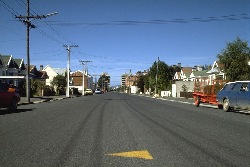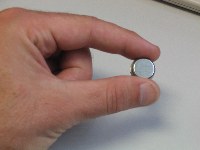Energy and Housing in Dunedin
Energy and Housing in Dunedin
University of Otago Department of Physics - Energy Studies Programme
In Cooperation with the Dunedin City Council/World Health Organisation
This project is now completed. The final report on the project can be downloaded below.
EVH3 - Impact of Housing on Health in Dunedin NZ (.PDF format ![]() , 976 KB)
, 976 KB)
Project Aim
 |
|
Castle St. Dunedin - © N. B. Tufillaro 2003 |
There is a large body of evidence that suggests a link between poor housing and ill health. The primary objective of this study is to assess the condition of the housing stock in the Dunedin City Council area with regard to the health of its occupants and to identify areas which may benefit from improvement. A general profile of housing in Dunedin City is presented. This profile examines the age and cost of Dunedin housing in comparison to other cities in New Zealand. Specific areas in Dunedin which are particularly sun-deprived are identified. A further in-depth survey of 91 student houses and flats is carried out in order to establish a base-line of thermal conditions in this generally considered poor housing sector. In addition the seasonal variation of mortality data for Dunedin is compared with the national average.
Student Housing Case Study
The case study was carried out as part of the practical assessment for one of the Energy Management 300 level courses on energy efficient building design (EMAN 306) and was funded specifically by the WHO/Dunedin City Council. The sample of houses was self-selected, as participants were solicited through various media and registered on a ‘first-come, first-served’ basis, provided they fitted the criteria; which were that houses surveyed were rented or leased accommodation and were occupied by at least one full time tertiary student. No pretence of a random survey was maintained and it is likely that the flats were representative of the “low end” of the student accommodation market.
 |
|
An iButton to scale |
The research involved placing two temperature sensors, one in the bedroom and one in the living room, in each of the student houses. The temperature sensors used in the survey were ‘iButtons’, manufactured by the Maxim/Dallas Semiconductor Corporation. These devices are small, robust digital thermometers that measure temperature to an accuracy of ± 0.5 °C (as verified by a calibration exercise). The iButtons were set to monitor temperature every hour over a period of approximately 2 months after which the data was downloaded for analysis. The sampling period started in early August 2003 and ended in mid October of the same year and thus covered the winter to spring transition period. Information was also gathered about the house and the inhabitants via a questionnaire.
For more information and results, please download the final report.
Contact: Please contact Bob Lloyd if you have any questions about this project

